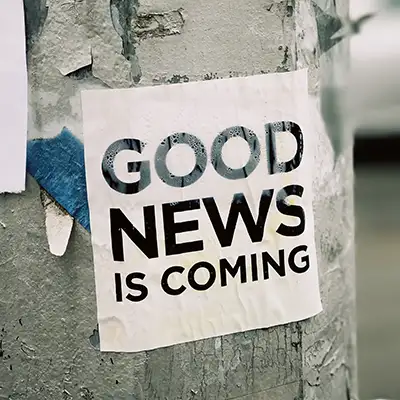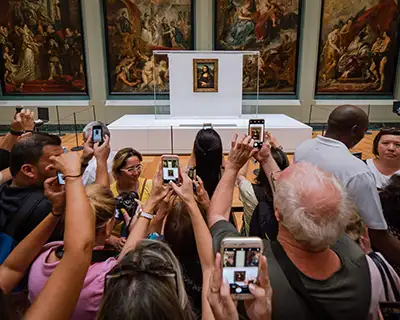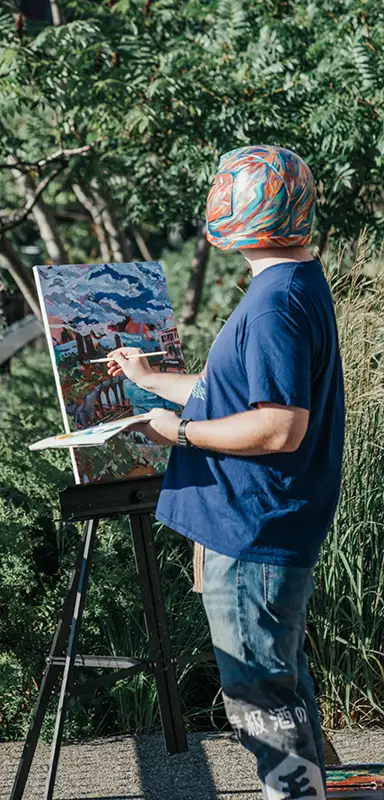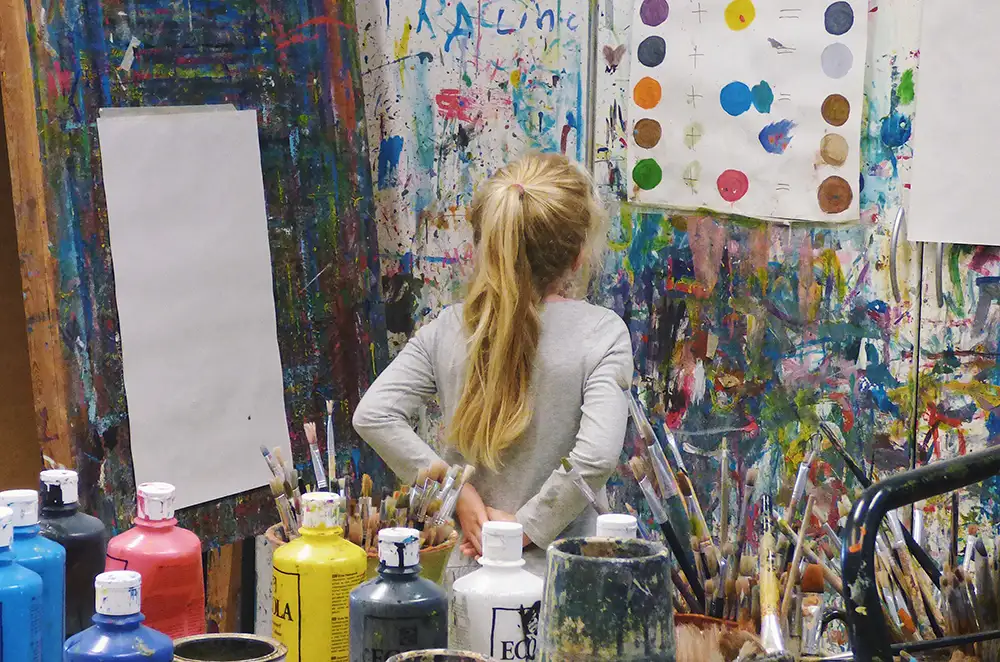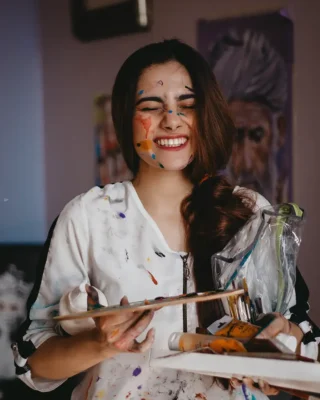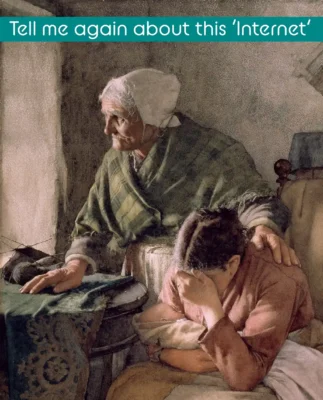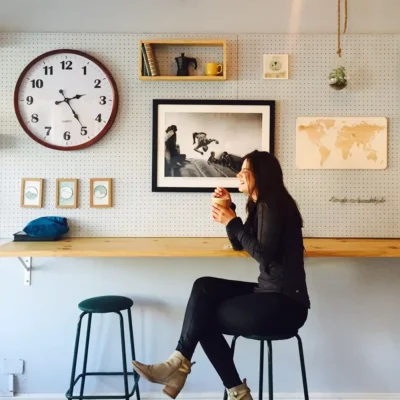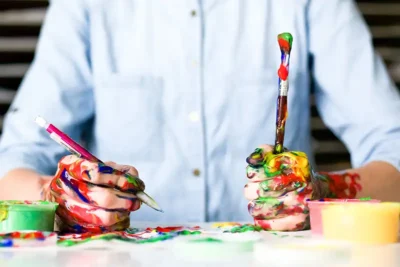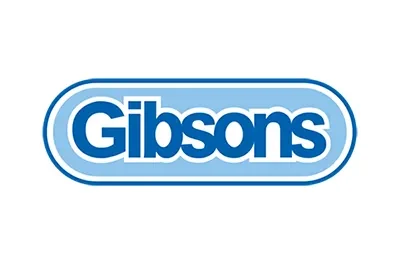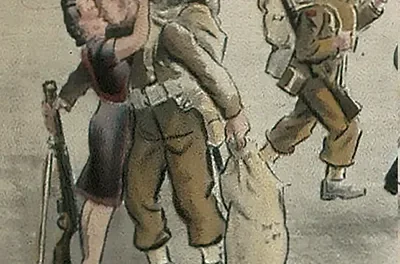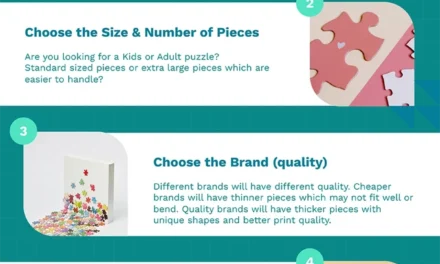How to Make Money from Painting!
Make money from your art by licencing it for a Jigsaw
Not every painting will make a great
Imagine if your picture was cut up into 1000 pieces (!). How many of those pieces would have no detail? How would you know where they fit into the
With over 20 years of experience as a former Director of Product Development at Gibsons, I have worked with dozens of talented artists including Janice Daughters below, and developed hundreds of successful puzzles.
I had always fancied having a go at illustrating jigsaws but never in my wildest dreams did I think it would be possible. We arranged a meeting at Gibsons stand the following day, and as they say, the rest is history.
One of the best days of my life.”
How to Make Money from Painting – Licence your Art for Jigsaw Puzzles!
You have spent days, weeks, months or even years on your art.
(I know one jigsaw
Now it is time for your art to reward you!
Licensing is not ‘selling’ your art for jigsaw puzzles.
It is better to say you are ‘loaning’ your art to be used in jigsaw puzzles for a limited time.
You retain the full copyright and are able to licence your art in other areas you choose, such as books & greetings cards.
Of course, you also keep hold of your original art to sell if you wish.
(or even licence again to a different company once your first licence term has finished).
How Large is the Jigsaw Puzzle Market?
The jigsaw
according to Market Reports.
Many new younger puzzlers found jigsaw puzzles for the first time during the covid lockdown,
and a whole new market for brighter, more modern jigsaw art designs was born.
Free Worldwide Marketing for your Art!
Jigsaw puzzles provide the ideal worldwide artist showcase.
A 1000pc piece jigsaw can take, on average, 10 hours – see my article on how long do jigsaw puzzles take?
So, a puzzles will appreciate your art for much longer than a browsing Art Gallery visitor!
The Jigsaw
– along with your name, bio, website and possibly even your other social media links – all for free!
This
It can be seen by thousands of customers in UK shops such as John Lewis, Waterstones, Selfridges, Harrods
and Kohl’s, Walmart and Barnes & Noble in the USA. These customers would never be able to see your art otherwise.
Once puzzlers have finished the
Jigsaw puzzles never get thrown away and become a mini travelling Art Gallery for you!
The best examples are Jigsaw puzzles donated to Jigsaw
– such as the one I visited in Newmarket, UK when I was at Gibsons.
(They also host the British Puzzle Championships!)
Who are the most successful Jigsaw Puzzle Artists?
Successful UK jigsaw
- Trevor Mitchell – The TV star from Yorkshire (as well as starring in his own jigsaw puzzles!)
- Janice Daughters – The lovely lady who has sold her art to The Queen!
- Steve Crisp – One of Gibsons most successful
- Matthew Emeny – who really is ‘Helping the Heroes’
Find out here what are the current most successful puzzles on Amazon UK
Some of the most successful worldwide jigsaw
- Thomas Kinkade– the ‘Painter of Light’
- Colin Thompson – The Whimsical Wizard.
- Charles Wysocki – The King of US nostalgia
- Jan van Haasteren – The Dutch comic master
Find out here what are the current most successful Jigsaw Puzzles on Amazon USA.
As you can see, there are hugely different styles.
Can you adapt your style to licence for jigsaw puzzles?
Who are the most successful Jigsaw Puzzle Artists?
Successful UK jigsaw
- Trevor Mitchell – The TV star from Yorkshire (as well as starring in his own jigsaw puzzles!)
- Janice Daughters – The lovely lady who has sold her art to The Queen!
- Steve Crisp – One of Gibsons most successful
- Matthew Emeny – who really is ‘Helping the Heroes’
Find out here what are the current most successful puzzles on Amazon UK
Some of the most successful worldwide jigsaw
- Thomas Kinkade– the ‘Painter of Light’
- Colin Thompson – The Whimsical Wizard.
- Charles Wysocki – The King of US nostalgia
- Jan van Haasteren – The Dutch comic master
Find out here what are the current most successful Jigsaw Puzzles on Amazon USA.
As you can see, there are hugely different styles.
Can you adapt your style to licence for jigsaw puzzles?
How to Licence Your Art for Jigsaw Puzzles?
Having spent over 20 years developing jigsaw puzzles for Gibsons – one of the largest jigsaw
I know how hard it is to become a successful jigsaw
The worldwide jigsaw
Getting noticed takes a lot of time, persistence and knowledge of what their art buyers are looking for.
What type of art are they looking for? What are the financial terms? How long is the commitment?
How can I develop my art style to make a successful long term career in jigsaw puzzles?
If you want to learn more, subscribe below and contact me directly.
I can guide you through some exciting new possibilities!
From 2004 to 2022, my primary contact and collaborator at Gibsons was Geoff Lee.
Geoff is immensely likeable, and I always really appreciated his input
in creating all those 4
Best ways to Make Money as an Artist?
(aside from Jigsaw Puzzles)
The Art World has changed!
Below, I will outline other ways to make money from your art, and the exciting new opportunities in this new online world.
How & Why to set up your own website, Print on Demand, The Digital Art marketplace & Online Global Teaching.
“Online art sales rocketed during the pandemic, from 4.8% in 2019 to 64% in 2020.
Further strong sales growth of 72% for the first half of 2021 reported by online art sales platforms gave us projected online sales for 2021 of $13.5 billion”
Sell art online with your own personal website
Are you looking for a showcase for your art?
Or, a fully functioning e-commerce shopping site where you can take & fulfil orders from online customers?
Pros
- Your own brand & design. There is no need to follow the template of other websites, such as Etsy.
- Services – you can provide extras such as Online courses
- Nobody can take your website away – you aren’t dependent on another company allowing you on their website.
Cons
- You are an artist, not a website designer.
Do you want to deal with GDPR data protection issues and internet security? - Time – do you have time to learn how to build a website?
Can you find and choose the right domain & hosting platform for your website? WordPress, Wix, Shopify? - Cost – some websites come with built-in shopping, such as Shopify.
These can be great but expensive – from £25 a month plus credit card fees. - If you choose the wrong platform, it may be easy to use initially, but you soon find its limitations. Or you may be locked into expensive monthly payments.
After lots (& lots!) of research, I decided on WordPress and Divi as a good combination of ease of use and features at a reasonable cost. - Will your website be a credit to you, or will it actually discourage potential customers?
- Once a website is built, how do you attract people to visit?
It can take just days to build a website using a pre-built template with no other options, but it is generally accepted to take up to six months to gain a good amount of viewers and even longer to get on that precious first page on Google. - Have you got time to learn about SEO techniques, keyword research & backlinks? I know from building this website how much time & research is needed!
Sell art online with your own personal website
Are you looking for a showcase for your art?
Or, a fully functioning e-commerce shopping site where you can take & fulfil orders from online customers?
Pros
- Your own brand & design. There is no need to follow the template of other websites, such as Etsy.
- Services – you can provide extras such as Online courses
- Nobody can take your website away – you aren’t dependent on another company allowing you on their website.
Cons
- You are an artist, not a website designer.
Do you want to deal with GDPR data protection issues and internet security? - Time – do you have time to learn how to build a website?
Can you find and choose the right domain & hosting platform for your website? WordPress, Wix, Shopify? - Cost – some websites come with built-in shopping, such as Shopify.
These can be great but expensive – from £25 a month plus credit card fees. - If you choose the wrong platform, it may be easy to use initially, but you soon find its limitations. Or you may be locked into expensive monthly payments.
After lots (& lots!) of research, I decided on WordPress and Divi as a good combination of ease of use and features at a reasonable cost. - Will your website be a credit to you, or will it actually discourage potential customers?
- Once a website is built, how do you attract people to visit?
It can take just days to build a website using a pre-built template with no other options, but it is generally accepted to take up to six months to gain a good amount of viewers and even longer to get on that precious first page on Google. - Have you got time to learn about SEO techniques, keyword research & backlinks? I know from building this website how much time & research is needed!
I’m currently designing a website for a lovely artist using WordPress + Divi.
This is excellent as I can customise it with :
a ‘Magnifying Glass’ to show the detail in her paintings (especially useful on mobiles)
Numbered ‘Hotspots’ which enabled her to highlight different areas of the painting and tell the stories behind them.
Creating an Art Blog
A blog can be slightly different from a traditional website, which may have the same content for months for even years.
A blog can show your work, but will also show more about you as an Artist.
You can write a blog post about anything, such as your interests outside of art. This will help build your ‘brand’ and connect with your customers.
It can enhance your reputation as an expert in a particular field
– especially useful if you have a niche, such as painting for jigsaw puzzles!
It may take months to paint your next masterpiece,
so with a blog, you can update your website with other news to keep it fresh (and also keep it ranking in Google) .
A good example of an artist blog is Matthew Emeny where he gives fascinating insights into each of his paintings – https://emenyart.com/blog/
Making money from your Artist website or blog
Once you have your gallery online, you can offer your viewers the chance to buy your art.
You can do this directly through a website with a shopping basket and display the products you want to sell. Two methods would be to set up a Shopify website or a custom designed website using a program called Woocommerce. A big topic to be discussed in another article!
Or through Affiliate Marketing – where you link to other websites which sell your art. An example would be Amazon Associates, where your website has links to the Amazon page selling your jigsaw
This costs absolutely nothing for your buyer, and Amazon will actually give you a small percentage
– typically 3% as a thank you for the introduction. It is something I use to help keep this website running.
Print on Demand for Artists
There are now several companies who offer ‘Print on demand’.
This is a service where you can upload your design to the company’s website.
They can then print your artwork onto hundreds of different products, such as canvas, clothing, and even furniture.
As printing is done ‘on demand’, it has the advantage of no stock being made or so no payment upfront.
The company can also handle the entrie customer ordering process, including worldwide delivery.
Pros:
- No hassle – these companies do everything, including order taking, worldwide delivery & customer service.
- There is little or no upfront cost as products are made to order, and no stock is held.
- Huge variety of products available to showcase your artwork.
- Worldwide market
- It can integrate with your existing website via Woocommerce, or your Shopify / Etsy store.
Cons:
- Commission – this can range all the way up to 90%
- Pricing – as products are made to order, pricing is naturally higher than a mass produced product.
- Depending on the company and location, delivery times can be longer.
- Print on Demand Companies include:
- Printful
- Printify
- Prodigi (UK)
- Two Fifteen (UK)
- Drool (UK) – also an Art marketplace
- Contrado (UK) – this is the company I use for my own jigsaw puzzles.
“Nearly half (47%) of new art buyers (those who started buying art less than three years ago) made their first art purchase online, compared to 30% in 2020″
Stock Art websites
These are huge online galleries showing art from thousands of different artists.
- Saatchi Art – describes itself as ‘the world’s leading online gallery’. 35% commission
- Artfinder – focused more on independent artists not showing in art galleries.
- Degree Art (UK) – focusing more on students
- Art2Arts (UK)
Shutterstock and Alamy – famous for selling photographs but do also sell paintings.
- Etsy & NotontheHighStreet – selling not just art but any gift!
Pros
- Getting noticed – it can be extremely tough for buyers to find you & your art. These websites already have thousands of buyers visiting them and looking to buy art.
Cons
- Very high commission – generally 35 to 90%
- Competition from other artists – you will need to optimise your art ‘posting’ to get noticed.
- Branding – or rather no branding, although you get an Artist biography page with a logo.
There are also the websites such as Unsplash who offer free images. They won’t make you any money but can get you some free publicity & awareness.
A reminder that when you sell on these websites, you sell a general licence, so you have no control over where your art is used.
Stock Art websites
These are huge online galleries showing art from thousands of different artists.
- Saatchi Art – describes itself as ‘the world’s leading online gallery’. 35% commission
- Artfinder – focused more on independent artists not showing in art galleries.
- Degree Art (UK) – focusing more on students
- Art2Arts (UK)
Shutterstock and Alamy – famous for selling photographs but do also sell paintings.
- Etsy & NotontheHighStreet – selling not just art but any gift!
Pros
- Getting noticed – it can be extremely tough for buyers to find you & your art. These websites already have thousands of buyers visiting them and looking to buy art.
Cons
- Very high commission – generally 35 to 90%
- Competition from other artists – you will need to optimise your art ‘posting’ to get noticed.
- Branding – or rather no branding, although you get an Artist biography page with a logo.
There are also the websites such as Unsplash who offer free images. They won’t make you any money but can get you some free publicity & awareness.
A reminder that when you sell on these websites, you sell a general licence, so you have no control over where your art is used.
“Art buying habits – the change is permanent:
In 2020, 51% of art buyers said they thought the changes in how they bought art were here to stay.
Fast forward 18 months [to 2022], and 84% now believe the digital shift in the art market will become permanent.”
The online art market has become an entrance into the art world for new art buyers,
many of whom have never ventured into a gallery or auction house.”
What does NFT stand for in art?
You may have read all about these and wondered what they are?
“Eight out of ten (82%) NFT buyers said that it was more about the money than the art, with 95% of those spending $25,000 on NFTs in the past 12 months and citing investment returns as the key reason for their NFT purchase.” Hiscox Online Art Trade report 2021
An NFT (non-fungible token) is basically a ‘unique’ token which can act as a certificate of ownership for a piece of art.
Bored Ape Yacht Club – 10,000 unique cartoon apes were the most famous example.
Millions of dollars changed hands in 2021/2 amongst NFT speculators but the market has now slumped.
A year later, the government dropped its original April 2022 plans for the Royal Mint to produce ‘NFTs for Britain’.
Traditional Art Galleries, Fairs & Commissions
The conventional, best & most challenging way?
For most painters, this would be the ideal route. Somebody sees your original art in a gallery or Art Fair and wants to buy it for their wall.
Or even better, somebody asks you to paint a portrait of them or their cockapoo!
Try : The Other Art Fair (US, London & Australia)
& The Affordable Art Fair (London).
Do remind any potential buyer that, you as the artist, still keep the copyright. Therefore you can still reproduce the art in different ways
– maybe even as a jigsaw
Coffee Shop Art?
There are many ‘non-galleries’ such as hotels or coffee shops who display art on their walls for sale, especially of local scenes.
Last summer, I was surprised and impressed to see actual paintings in the breakfast room of a country hotel we stayed at. The artist is now featured on the hotel’s TripAdvisor review by a couple of buyers. Do leave your name on the painting, though, so people can search for you.
Try bringing your portfolio to the owner of your local hotel or restaurant. A real painting for them to display, and great free publicity for you.
Coffee Shop Art?
There are many ‘non-galleries’ such as hotels or coffee shops who display art on their walls for sale, especially of local scenes.
Last summer, I was surprised and impressed to see actual paintings in the breakfast room of a country hotel we stayed at. The artist is now featured on the hotel’s TripAdvisor review by a couple of buyers. Do leave your name on the painting, though, so people can search for you.
Try bringing your portfolio to the owner of your local hotel or restaurant. A real painting for them to display, and great free publicity for you.
Teach Art Online
Teaching can be traditional with in-person art classes,
or now through the new teaching art online courses.
Online courses will take a lot of initial effort to produce & edit, but once created, they can reach a vast worldwide audience and provide income for years – something which is very popular now – ‘passive income’!
Popular teaching online courses include: Udemy, Skillshare and LinkedIn
Finally … Freelance or Employment?
Unfortunately, very few companies are looking for full-time artists or illustrators.
There are jobs for graphic designers however to work with art,
and incorporate it into books, board games, video games and jigsaw puzzles.
The vast majority of art that companies use comes from freelance artists.
The big question is – how could I become a freelance artist for those companies?
Could you be an Artist who paints, or takes photographs for Jigsaw Puzzles?
Finally … Freelance or Employment?
Unfortunately, very few companies are looking for full-time artists or illustrators.
There are jobs for graphic designers however to work with art,
and incorporate it into books, board games, video games and jigsaw puzzles.
The vast majority of art that companies use comes from freelance artists.
The big question is – how could I become a freelance artist for those companies?
Could you be an Artist who paints, or takes photographs for Jigsaw Puzzles?
I had always fancied having a go at illustrating jigsaws but never in my wildest dreams did I think it would be possible. We arranged a meeting at Gibsons stand the following day, and as they say, the rest is history.
One of the best days of my life.”
So … How to Make Money from Painting?
(Licence your art as a jigsaw puzzle !)
Fortunately, we all have new, exciting opportunities in this modern world.
We can show our art worldwide & teach online – all at a minimal cost.
There are even companies who will do everything for us – showcase our art,
take an order from a customer, print our art and then send it out worldwide!
Don’t forget that you can sell, teach & showcase your art,
and at the same time
licence your art for Jigsaw Puzzles to get extra income
with all the fantastic, free worldwide marketing too!
If you want to learn more about licensing your art in jigsaw puzzles, just click below!
From 2004 to 2022, my primary contact and collaborator at Gibsons was Geoff Lee.
Geoff is immensely likeable, and I always really appreciated his input
in creating all those 4
This website is supported entirely by my kind readers - thank you so much for visiting! There are no adverts, and I don't accept any payment for reviews or sponsorship of any product. Instead, there are some links where, if you buy something, I may earn an affiliate commission. As an Amazon Associate, I earn from qualifying purchases at no cost to you. If you do choose to buy through my links - a genuine big thank you!

